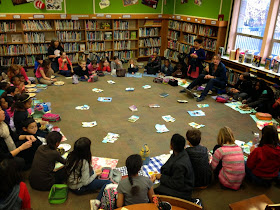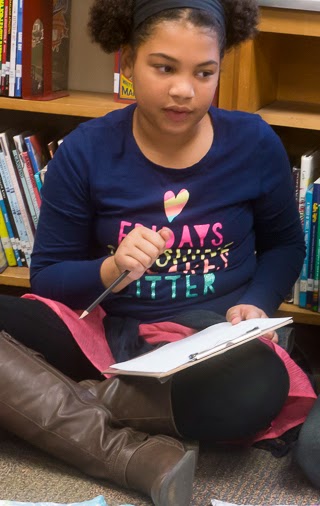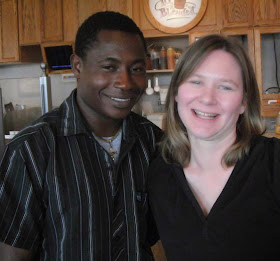Our students have had passionate, thoughtful conversations all year, recommending books to one another, considering which book they liked and why it resonated with them. Throughout, we talked about the key components of literature and storytelling: character development, plot and pacing, setting, language and themes.
Ever since I first shared Kwame Alexander's
The Crossover with Emerson students, it was clear that this book spoke to our students in a unique way. It's been fascinating listening to kids talk about why.
The Crossover
by Kwame Alexander
Houghton Mifflin Harcourt, 2014
my full review
Your local library
Amazon
ages 9-14
From the very first page, the language of
The Crossover pulls young readers right into the rhythm and feelings of a fast-moving basketball game. Just look at the opening lines and you can see the combination of basketball terms, rhythm and rhyme, and downright attitude.
"At the top of the key, I'm
MOVING AND GROOVING,
POPping and ROCKING--
Why you BUMPING?
Why you LOCKING?
Man, take this THUMPING,
Be careful though,
'cause now I'm CRUNKING"
As Norah said, "It's not quite rhyming, but it's almost like rap, like a song." Mahari added that he likes the form of poetry: "It made it more interesting for me as a reader. The language conveyed the character's feelings." Norah added that it isn't just printed normal on the page. Kids really noticed that the way the words are arranged enhanced the way language conveyed both character's feelings and the author's message.
Other students commented on the character development in
The Crossover. Maddy said that she "felt like she was there with the characters at every move" (that word choice seemed so appropriate to me, since there's so much movement in this story). Kids could really see twin brothers Josh & J.B. as distinct characters and relate to the tension between them. Madeline added that she felt their father was a very detailed character, because Alexander showed how much he loved basketball but how he also really loved his family.

I asked students if they felt that they could see what was coming (in other words, was the plot too obvious?), and they really felt like they were right there with the characters. While some might have had an idea of the foreshadowing, they really didn't notice the signs that the mother was concerned about the father's health -- certainly not the way adult readers would notice.
Several students commented on how
The Crossover made them think a little more about what they were reading. They liked how the titles of the poems related to the themes and the plot--giving them a sense and focus. Several other students talked about how they had to take a second, reread a passage and ask what the author was really saying. I think this attests to Alexander's nuanced, layered language.
Historical fiction often draws the attention of the Newbery committee, and I was happy to see students respond so passionately to Kirby Larson's story about Japanese internment during World War II. "
Dash is one of the best books I have ever read!"
Dash
by Kirby Larson
Scholastic, 2014
my full review
Your local library
Amazon
ages 9-12
Here's Abby's recommendation from early September: "If you like dogs a lot, you'd probably love it. If you like books with hardship and struggle, you'll probably like it. It's also heartfelt, with a lot of love. Every single chapter keeps you hanging." She passionately shared this book all year long.
Right from the beginning, young readers relate to how alone Mitsi feels when her friends start avoiding her -- all because of something that happened in a war far, far away. Larson creates a unique, distinctive character, but focuses on elements that many readers can relate to. Just as I write that sense, I realize what a tricky balance that is!
"The author describes Mitsi's emotions so well, her love of being an artists and her talents and passion. She brings out who she is and who she wants to be. I could imagine what she looks like and what she's feeling at the moment."
Abby said, "The setting and details of the characters and their experiences were amazing. I could picture it like a movie in my mind---they
should make a movie of it!" I would agree with Abby, especially noting the way I could picture the different camps in my mind and how the harsh conditions made life so much more difficult for Mitsi's family.
 |
| Mitsi Shiraishi and her beloved dog, Chubby -- inspirations for Dash |
I was particularly moved reading in
Kirby Larson's blog this letter from Louise Kashino, who endured experiences similar to Mitsi's:
I read DASH and poured over every sentence inasmuch as I was 16 when we were incarcerated on May, 1942. My family was assigned to Area D inside the Puyallup Fairgrounds, where our barrack among others was built inside the racing grounds. I don't know who guided you through the whole incarceration, but you did an excellent job of describing the experiences for someone like me. I also relocated to Chicago and eventually returned to Seattle, so again, your description of the whole movement brought back many memories. Thank you for your accurate descriptions of our experience to give the general public an insight into what we experienced during our incarceration.
We had a rousing discussion about
The Fourteenth Goldfish, with students arguing on both sides of the fence. It had real supporters and others who just weren't drawn into it.
The Fourteenth Goldfish
by Jennifer L. Holm
Random House, 2014
my full review
Your local library
Amazon
ages 9-12
Overall, my students loved Jennifer Holm's blend of realistic relationships, humor and science with a touch of fantasy. Maisy said, "It's a really good book because it has lots of science, but not too much so you can't understand it." I am impressed with how well Holm understands her audience, adding in just enough layering of science to introduce students to the history of science and scientific thinking without overwhelming young readers.
Some students really enjoyed the fantasy elements. Talia noted that it reminded her of Tuck Everlasting. But other students found it a little confusing, especially at the beginning when Ellie is figuring out that this teenager is actually her grandfather.
I would actually venture to guess that the students who liked it were drawn in by the themes of the story -- the idea that you can figure out a solution, that things are possible if you work at a creative solution, and the idea that grandparents and grandchildren actually have a lot more in common if they could only discover a little more about each other as real people.
The review copies came from my home collection and our library collection and our classroom collections. Early review copies were also kindly sent by the publishers: Houghton Mifflin Harcourt, Scholastic, and Random House. If you make a purchase using the Amazon links on this site, a small portion goes to Great Kid Books. Thank you for your support.
©2015 Mary Ann Scheuer, Great Kid Books



















.jpg)












.jpg)












.jpg)
